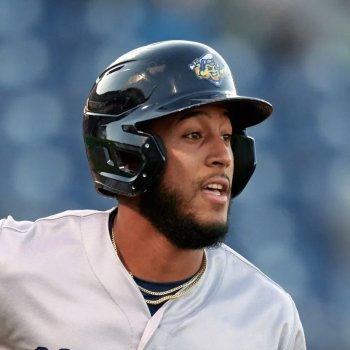
Twins Video
Marwin González probably profited from the Houston Astros’ systematic sign-stealing efforts in 2017 and 2018, in ways we can clearly identify using advanced data. After he signed with the Twins last winter, however, González also profited from Minnesota’s hitting philosophy and instruction. Thus, while you shouldn’t expect him to repeat or approximate his gaudy 2017 numbers in 2020, there are reasons to believe he can be a similarly valuable (though different) super-utility slugger.
Early in his career, González battled persistent problems recognizing and laying off non-fastballs outside the strike zone. He did good work against heaters, but was too easily exploited by pitchers who could command secondary stuff. In 2017, however, his chase rate on junk outside the zone dropped sharply, and González’s production surged accordingly.
In hindsight, thanks to the information that has come to light since, it seems safe to assume González was getting help from Houston’s banging scheme. Since that year, and particularly after leaving Houston for Minnesota, he’s been unable to replicate that improved plate discipline. His walk rate in the two seasons prior to 2017 was just north of 4 percent. His walk rates in 2017 and 2018 were just south of 10 percent. In 2019, he walked just 6.7 percent of the time.
However, it’s not fully clear that González solely shored up his plate discipline in those seasons as a result of sign stealing. He was at an age and in a situation that encouraged a maturing, increasingly selective approach, and might have simply made that conscious decision. Then, in coming to the Twins, he both faced pressure to live up to a multi-year deal and was immersed in a team whose baseline hitting mentality is more aggressive. He might have swung more often in 2019, not because he forgot how to be patient or lost his secret edge, but because he simply felt more pressure and was trying to tailor his approach to that of his new club.
In any case, González also got something valuable in return for his increased aggressiveness: more pop. Despite leaving Minute Maid Park and coming to Target Field, which is a tough park on his power tendencies, González nearly matched his extra-base hit rate from 2018, and his underlying batted-ball data support that. In fact, those numbers suggest that he could have seen even better results.
That forward leap, in both average exit velocity and hard-hit rate, is very significant. A player in his 30s adding three miles per hour to that average exit velocity figure within a single season is nearly unprecedented. By tapping into his aggressiveness again, González found a lot more hard contact. He saw particular improvement in his ability to drive the outside pitch, as a left-handed batter, and in staying on top of pitches up in the zone, as a right-handed one.
Twins fans shouldn’t expect González to rebound to the kind of numbers he put up in 2017. That was probably a career year, sweetened by his team’s systematic sign-stealing. Still, there were drawbacks to hitting the way the Astros trained González to hit, including drawbacks to the banging scheme itself. The Twins have helped González realize his potential for avoiding the weakest and least valuable forms of contact, and for thumping the ball more consistently, even when an opposing pitcher executes well. On balance, he’s still a good player, likely to produce better in 2020 than he did in 2019, and having signs relayed to him did not turn him from some fringe big-leaguer into the fine utility player he is now.
MORE FROM TWINS DAILY
— Latest Twins coverage from our writers
— Recent Twins discussion in our forums
MORE FROM TWINS DAILY
— Latest Twins coverage from our writers
— Recent Twins discussion in our forums
— Follow Twins Daily via Twitter, Facebook or email
— Become a Twins Daily Caretaker







Recommended Comments
Join the conversation
You can post now and register later. If you have an account, sign in now to post with your account.
Note: Your post will require moderator approval before it will be visible.